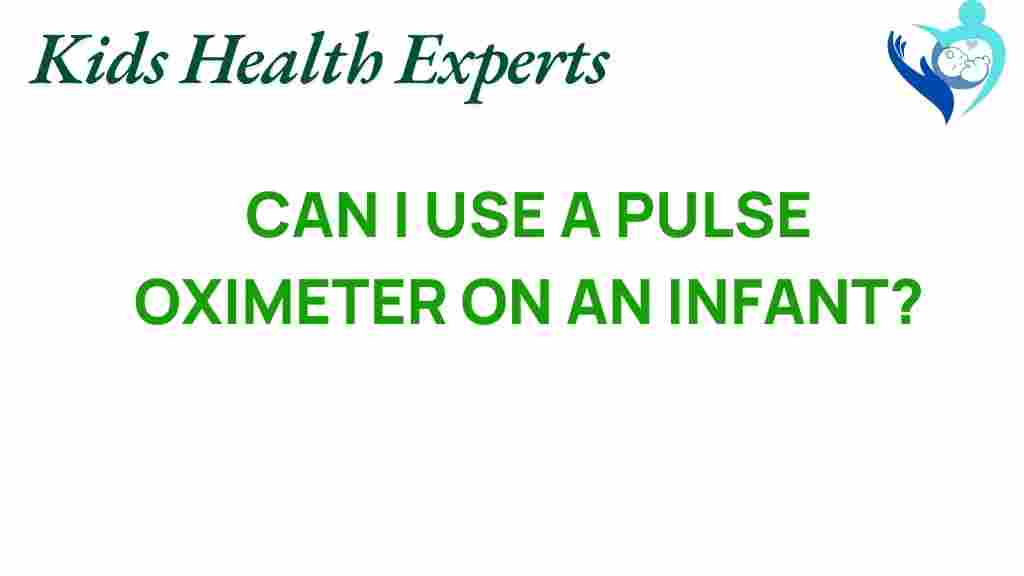Unveiling the Truth: Can a Pulse Oximeter Be Used on Infants?
In recent years, pulse oximeters have gained popularity as essential medical devices for monitoring oxygen levels in patients of all ages. However, when it comes to infant health, many parents are left wondering whether these devices are suitable for their little ones. In this comprehensive guide, we will explore the use of pulse oximeters in infants, their importance in pediatric care, and how they can help parents monitor their baby’s health.
What is a Pulse Oximeter?
A pulse oximeter is a non-invasive medical device that measures the oxygen saturation level in the blood. It works by emitting light through the skin and measuring the amount of oxygenated and deoxygenated blood. This information is crucial for assessing a person’s respiratory function and overall health.
Importance of Monitoring Oxygen Levels in Infants
Monitoring oxygen levels in infants is vital for several reasons:
- Early Detection: Low oxygen levels can indicate respiratory issues, which may require immediate medical attention.
- Post-Surgery Monitoring: Infants who have undergone surgery may need constant monitoring to ensure they are recovering properly.
- Chronic Conditions: Babies with chronic health conditions may benefit from regular monitoring to manage their health effectively.
Can a Pulse Oximeter be Used on Infants?
Yes, pulse oximeters can be used on infants, but there are important considerations to keep in mind:
- Size and Fit: Ensure that the pulse oximeter is suitable for infants, as some devices are designed for adult fingers and may not fit well on a baby’s tiny toes or fingers.
- Accuracy: Some pulse oximeters may not provide accurate readings in infants due to their smaller size and varying skin thickness.
- Type of Device: There are specific pulse oximeters designed for pediatric use, which are more appropriate for infants.
Choosing the Right Pulse Oximeter for Infants
When selecting a pulse oximeter for your baby, consider the following:
- FDA Approval: Ensure the device is approved by the FDA and specifically labeled for pediatric use.
- Comfort: Look for a device that is comfortable for your infant, minimizing distress during the monitoring process.
- Features: Some pulse oximeters offer features such as alarms for low oxygen levels, which can be beneficial for parents.
How to Use a Pulse Oximeter on Infants
Using a pulse oximeter on an infant may seem daunting, but it can be straightforward with the right approach. Follow these steps to ensure an effective monitoring process:
- Preparation: Gather the pulse oximeter and ensure it is clean and fully charged or has fresh batteries.
- Choose the Right Site: For infants, the best sites for placing the pulse oximeter are the toe or finger. Choose a site that is easily accessible and comfortable for your baby.
- Calm the Infant: Before using the device, ensure your baby is calm. Swaddling or gently holding your infant can help them feel secure.
- Place the Device: Gently place the pulse oximeter on the chosen site, ensuring it fits snugly but not too tight. Make sure the sensor is well-aligned with the skin.
- Wait for a Reading: Allow the device a few seconds to obtain an accurate reading. Most devices will display the oxygen saturation level and heart rate.
- Record the Results: Write down the readings for future reference, especially if you are monitoring your infant’s health over time.
What to Expect from Pulse Oximeter Readings
Normal oxygen saturation levels typically range from 95% to 100%. If you notice:
- Below 95%: This may indicate a potential issue, and you should consult your pediatrician.
- Consistently Low Levels: If readings are persistently low, seek medical advice immediately.
Troubleshooting Common Issues
While using a pulse oximeter on infants, you may encounter some challenges. Here are some troubleshooting tips:
- Poor Readings: If you’re getting inconsistent or poor readings, ensure the device is properly positioned and that the infant is calm.
- Skin Tone Factors: Darker skin tones may affect the accuracy of readings. If necessary, consult with a healthcare professional for guidance.
- Movement: Infants tend to move around, which can affect the readings. Try to keep your baby still during the measurement.
When to Consult a Pediatrician
As a parent, it’s crucial to know when to seek medical advice. If you observe:
- Persistent Low Readings: If oxygen saturation levels are consistently below 95%.
- Signs of Distress: If your infant shows signs of difficulty breathing, such as rapid breathing or wheezing.
- Changes in Behavior: If your baby becomes unusually lethargic or irritable.
Always err on the side of caution when it comes to your infant’s health.
Conclusion
In conclusion, a pulse oximeter can be a valuable tool for parents monitoring their infant’s health, especially concerning oxygen levels. Understanding how to use this health technology effectively can empower parents to take proactive steps in managing their child’s health. Always choose the right device, follow proper usage guidelines, and consult a healthcare professional when necessary. By being informed and prepared, you can play an active role in monitoring your infant’s well-being.
For more information on pediatric care and health technology, visit this resource.
If you’re looking for recommendations on specific models of pulse oximeters suitable for infants, check out this guide.
This article is in the category Care and created by KidsHealthExperts Team
